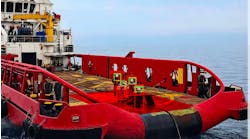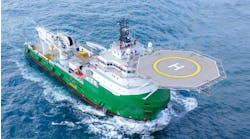Internet-based remote reservoir modeling and analysis
Internet-based remote reservoir modeling and analysis
A remote ongoing reservoir modeling and analysis feature by Vertex Petroleum Systems (VPS) has been integrated into the reservoir focus platform of Halliburton's Real-Time Reservoir Solutions (RTRS) system. This approach of combining the communication capabilities of the Internet, reservoir modeling technology, and broad experience accelerates time-critical reservoir management solutions.
Using a secure extranet website, designated RPF-Online, operators can enter well, production, and reservoir data. The data is used to build, history match, interpret reservoir models, and run both predictive analysis and production forecasts that are updated on a "rolling" basis every month. This information will enable operators to evaluate and optimize many reservoir exploitation options, including new well locations, spacing plans, completion methods, fracture parameters, production potential for new wells, and the economic impact of many different possible drilling and completion plans.
The simulation models well and reservoir situations, and provides a first-look type of analysis, identifying primary problem areas or when a more comprehensive reservoir study is warranted. The analysis has virtually no limitation as to the size, shape, or number of reservoirs that can be set up, or the number of wells, or the type of completions that can be included in a model.
First HT/HP reservoir drill-in using cesium formate
A milestone was achieved in the development of cesium formate drilling and completion fluid by Cabot Specialty Fluids. The high-density fluid was successfully used to drill and complete a reservoir section of a well in the Huldra Field in quadrant 30/2 in the Norwegian sector of the North Sea. The Huldra field is operated by Statoil on behalf of Conoco, Svenska, Petro-Canada, and TotalFinaElf, and is considered one of the most challenging high pressure, high temperature (HT/HP) developments yet undertaken in the Norwegian sector of the North Sea.
The 30/2-A8 well utilized a 16.28 ppg cesium formate-based drilling fluid to drill and then complete the reservoir section. Reservoir pressures exceeded 9,700 psi and bottom hole temperatures exceeded 140 degrees C. A 866-ft, 8 1/2-in. diameter hole was drilled through the reservoir at a deviation of 45 degrees. The well was TD'd at 14,760 ft measured depth.
The completion involved the installation of single-wire-wrapped sand screens across the reservoir to prevent expected sand production as reservoir depletion took place later in field life. This, along with improved and safer well pressure control was the key driver for the use of the formate fluid.
During the drilling phase, the mud properties were stable, with little or no maintenance required to keep them within the agreed specification. Drilled cuttings integrity and hole conditions were good, with no indications of instability in the exposed shale sections above the top of the reservoir.
After logging the reservoir, the drilling fluid was directed over fine shaker screens (400 mesh) to remove any coarse solids. The wire wrapped sand screens were run smoothly, followed by the completion string, without incident. The well is currently suspended to be production tested at a later date. Statoil's well engineers said they utilized cesium formate in this well because of the fluid's ability to provide the following advantages:
- Improved safety and control of well pressures
- Optimum well environment for running sand control screens
- Handling safety for crews
- Environmental acceptability.
The fluid was also tested and proved to be compatible with all major elements of the drilling (blowout preventer, surface equipment, measurment while drilling, logging while drilling, mud motors) and completion equipment (metals and elastomers), under conditions of high temperature and pressure.
Well-underbalanced drilling projects
Underbalanced drilling is a specialized drilling technique where the bottom hole pressure exerted by the hydrostatic head of the wellbore fluid column is less than the pressure of the formation being drilled. Employing this technique results in overcoming lost circulation zones, improves reservoir performance, and drilling wells into deeper depths within the formation.
Weatherford International, Inc.'s Drilling & Intervention Services division completed a three-well underbalanced drilling system operation for Minijos Nafta in the Pietu Siupariai Field in Lithuania. A production rate of 3,500 b/d was obtained on the first well within three months. By comparison, nearby offset wells produced at an estimated rate of 150 b/d. The remaining two wells in the project are producing at 2,700 b/d and 1,000 b/d, respectively.
Increased reservoir productivity by minimizing formation damage while obtaining a negative skin factor was achieved, the service company stated. The resulting pressure reduction to the wellbore further provided increased productivity and substantial savings. A full-underbalanced systems package including separation services and underbalanced completion running, as well as project management was provided.
Additionally, three wells in the Jatibarang field, near Cirebon, east of Jakarta for Pertamina, the Indonesian state oil company, have recently been drilled with the underbalanced system. The first two wells produced an average of about 3,000 b/d, approximately four times the production of the best conventionally completed wells and over eight times the average production of existing wells. Operations on the third well are not yet complete. Based on these results, Pertamina decided to drill nine additional wells in the Jatibarang field using underbalanced technology that included onsite project management, nitrogen generation services, rotating pressure control, and separation services.
Downhole, subsea camera withstands harsh conditions
A new subsea/downhole camera system should improve the industry's ability to observe the condition and activity of operations onsite rapidly and effectively. The real-time digital Camscan by the UWG Group enables 360-degree pan and 90-degree tilt in order to inspect and observe the full extent of subsea or downhole activity at depths up to 6,000 ft.
Limitations to the field of vision of traditional camera systems and restrictions on the deployment of remotely operated vehicles during adverse weather conditions can result in reduced reliability of the information gained and delays in sourcing essential information. These problems, in conjunction with mis-identification of footage when viewed by untrained eyes, can contribute to lost rig time and poor development decisions, compromised by an incomplete understanding of the subsurface activity. To eliminate these uncertainties, the camera system provides footage of any situation from any angle.
In order to maximize functionality, the system has layers of redundancy. For example, footage can be obtained even if some of the circuits fail. The system consists of twin cameras (color and black and white) inside a 6 1/4-in. outside diameter camera head, which can perform 100% backup of footage in the event of individual camera failure. Twenty-eight light-emitting diodes on four separate circuits ensure continuity of light if one circuit fails (only six LEDs are needed for filming). The Kevlar reinforced umbilical transmits digital signals, with redundancy, to the digital control/recording unit on the surface. The system allows downloading and live electronic transmission of digital images.


